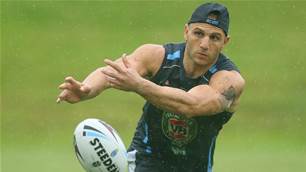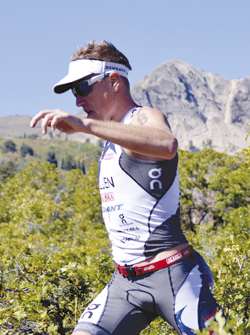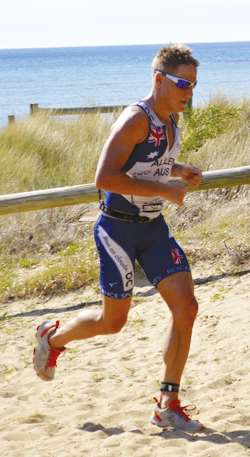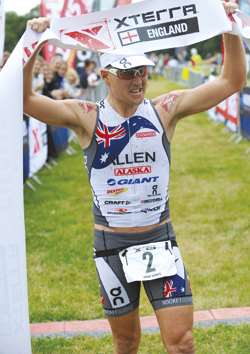How to prepare like Australia's hope at the Xterra Worlds, Ben Allen.
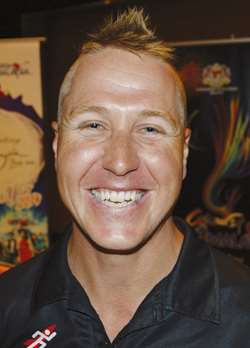 WOLLONGONG professional triathlete Ben Allen is a rarity. Not because he also competes in a form of triathlon a tad different to the version most of us are used to. And not because he sprinkles chia seeds over his breakfast. He’s an Australian national treasure because, well, he beats Poms. Regularly. In fact, at the recent Xterra England Championship, he beat a whole field of them. He had to watch that his celebrations didn’t get too out of hand, though – his better half, Jacqui Slack, a fellow Xterra star and women’s winner in England, just happens to be English ...
WOLLONGONG professional triathlete Ben Allen is a rarity. Not because he also competes in a form of triathlon a tad different to the version most of us are used to. And not because he sprinkles chia seeds over his breakfast. He’s an Australian national treasure because, well, he beats Poms. Regularly. In fact, at the recent Xterra England Championship, he beat a whole field of them. He had to watch that his celebrations didn’t get too out of hand, though – his better half, Jacqui Slack, a fellow Xterra star and women’s winner in England, just happens to be English ...
The sport of Xterra is off-road triathlon, featuring swimming, mountain-biking and trail-running legs. Your average event might demand a 500m swim through a pristine national park lake, a 15km bike ride across rocky, mountainous terrain, and
a 5km trail run through breathtakingly beautiful rainforest, with distances roughly doubled for the big-stage events. To
say Allen is one of the top guns of the men’s Xterra universe would be an extreme understatement. His email signature reads thus: two-time Xterra Asian Triple Crown World Tour champion, 11-time Xterra World Tour race champion, Xterra Trans Tasman champion, Ironman 70.3 podium, runner-up at USA Xterra and Xterra Warrior Award champion.
Needless to say Allen is a front-runner in the Xterra World Tour as well, a 24-leg series which traverses the globe. Inside Sport caught up with Allen with the Xterra World Championships rapidly approaching (Maui, October 27). As you’ll discover, he’s a champion preparer as well as a mongrel competitor. And hey, if Jacqui wins her race at the upcoming Worlds, we just might even send a cheer for her, too ...
NO DRAFTING
“A major difference between Xterra and regular triathlons is that there’s a gap between you and your fellow competitor while you’re out on the bike. The minimum distance between your front wheel and the competitor ahead of you is seven metres – it can be stretched to 12m depending on the course. To me, this version is more of an honest racing format. You’re on the bike pushing as hard as you can. In draft-legal races, you’re racing against another person; you can team up and help each other in order to ride faster. Often you’re aiming to save a bit of energy here and there.
“Personally, I want to feel that once I’ve finished a race, I’ve put it all on the line; given 110 percent.
I find that with non-drafting you can really push yourself beyond your abilities and see how far you can improve.”
“Off-road events are more gruelling than normal triathlons because your whole body is involved. In the mountain-biking and trail-running legs you’re often negotiating rocky sections, running through mud, up and down waterfalls, traversing mountains you can’t see the tops of, zig-zagging in and out of forest ... It takes a big toll on your body. To be able to prepare yourself, you need to go out and explore what nature has to offer. I think that’s the beauty of the sport I race in: you don’t know what’s going to come up next.
“Often you come across obstacles which you don’t think you’ll be able to conquer. At the recent Xterra in England, there was a two-and-a-half-metre creek jump. Out of the many people who couldn’t get over it in training, so many of them were able to during the race. It’s just amazing what the mind can allow you to do in the heat of the moment. The sport allows people to think beyond their capabilities and challenge their own minds and physical abilities.”
DIFFERENT SPOKES
“I complete in many different types of triathlons, which keeps me fairly busy. I have to try and maintain my skills on the mountain bike to enable myself to race at the highest level in the off-road triathlon world. That means I might have to sacrifice a couple of swimming and running sessions just to maintain an elite-level of technique on the mountain bike; to be competent enough to finish at the pointy end of the scale. The different styles of racing keep me honest. One week I’m on the mountain bike, next week I’m on my other bike doing a 90km time trial, head down, going for it, just worrying about watts and heart-rate. The next week it might be a French grand prix; short, sharp racing on the road bike. I’m always switching between the three.”
GETTING INTENSE
“In my intense block of training I’ll complete a four-week program where I’ll have a week of very steady work; some short interval sessions. The first week might entail between 12 hours of swimming and anywhere between 20-25 hours of riding, and then between 80-90km of running. It steps up ten percent each week after that for a few weeks, before a week’s }recovery for the fourth; just letting the body absorb all the kilometres I’ve done and making sure I have adequate rest.”
RECONNAISSANCE
“Jacqui and I organise our schedule so that we arrive at the destination of our next race a couple of days before. We like to ride the course, get a feel for it, check out any really technical aspects, gnarly descents or really big climbs. It’s vitally important to have a sharp attention to detail; on race day you’re going at a million miles an hour and all of a sudden there could be a left-hand turn with a steep rocky descent. You need to know what’s coming next in order to prepare yourself to negotiate that tricky technical section so you can ride it as fast and as safe as possible. You don’t want to come off and crash and lose time. If you can go out and check the course and find out where the best places to overtake on the run leg are and where you can really put the hammer down and try and break your competitors, it definitely gives you an advantage.”
THE WET STUFF
“The swimming leg would be one of my strengths among the three disciplines. I’ve represented Australia at three world life saving titles. I grew up on the beach and competed in surf life saving as a nipper. I’m lucky that my parents got me into swimming at a young age.
I wish there were some bigger waves on some of the courses we tackle; the majority of our swimming legs are in lakes. I’m pretty laid back and relaxed in a swim leg. I exit the water almost always first in an Xterra race.”
“At first my running training is very slow; I do a lot of slow, steady miles in order to be able to build a base. Then I use that base to do some intense work and that’s where I get my speed. It’s just about aiming your strength and endurance to be able to last the distance and be able to maintain a really fast, quality run. I’ll usually run about 110-120km each week, or between 16-24km a day. That’s in a base phase, but in between races I back it off to between 80-90km a week.
“During running training I just try and concentrate on my stride rate, technique, form, making sure I’m running upright, looking straight ahead. Although, when you’re running off-road, you really need to pay attention to the terrain and where you’re putting your feet on the ground, and make sure that you have a really good platform underneath.”
BIG WHEELS
“I ride a Giant XTC 29. It’s just phenomenal. It’s the best carbon-fibre frame you can get; really light and stiff for when you’re climbing up steep, technical climbs. It handles really well
on rough courses.
“The 29er is a larger-diameter-wheeled bike, too. We used to ride the 26-inch-wheel bike, but with the technology that Giant has put into the bikes, they’ve found that a bigger diameter has better rolling resistance compared to the 26-inch. The bigger wheel allows the bike to roll a lot faster and easier and over technical sections. A lot of my competitors use the 29-inch wheel bike, too.
In saying that, with the latest technology that’s coming out now, Giant has done a lot of testing and has found the bike in the middle, the 27.5, is even more advanced than the 29.
I’ll be riding one of those come next year.”
“The chia seed is working fantastically well for me at the moment. It’s a great source of Omega-3, really high in protein, iron, magnesium, zinc and high in fibre. It’s also a gluten-free product. It’s just a little seed; perfect. I put a little bit on my breakfast cereal, or stir it into some yoghurt or into a smoothie. It’s everything you need for a nutritious, healthy kick-start to the day. At a lot of the destinations I go to, it’s hard to find good-quality and high-protein foods. Chia seeds give you that overall balance to help you recover from training sessions and be able to bounce back and feel as good as possible.”
GLOBE-TROTTER
“I just love what the sport offers, like travelling around the world to some amazing destinations. I’ve had the opportunity to race in the Philippines, in Cebu. Beautiful beaches where the people are so friendly and welcoming. I’ve raced in Guam, Saipan, Greece, England, Switzerland, Spain, the US. We have our World Championships coming up on October 27 in beautiful Maui in Hawaii. Not a bad place to finish the Xterra World Tour ... ”
− James Smith
Related Articles
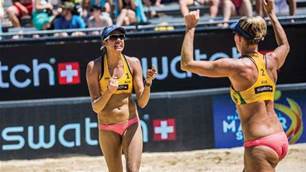
How Australia's beach volleyball women train

How Australia's beach volleyball women train
